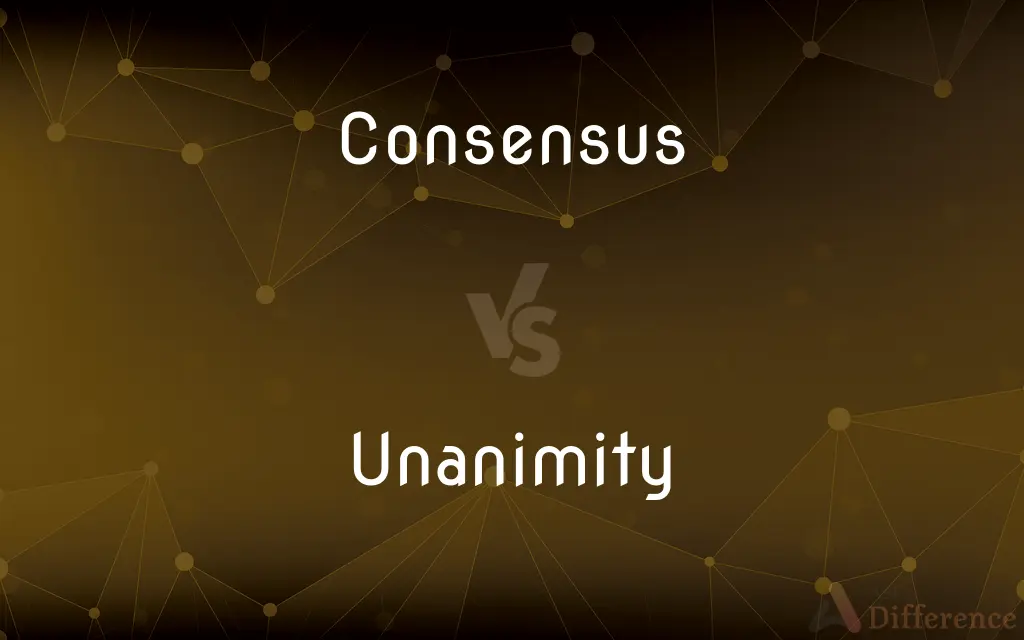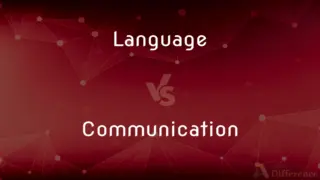Consensus vs. Unanimity — What's the Difference?
By Tayyaba Rehman & Fiza Rafique — Updated on April 25, 2024
Consensus is a general agreement among a group, typically achieved through discussion and compromise, while unanimity requires all members to agree fully without any dissent.

Difference Between Consensus and Unanimity
Table of Contents
ADVERTISEMENT
Key Differences
Consensus involves reaching a general agreement that most, but not necessarily all, group members can accept. It often requires negotiation and compromise to address the diverse viewpoints within the group. On the other hand, unanimity is achieved when all members of a group completely agree on a particular decision or opinion, reflecting total agreement without exception.
While consensus does not require every member's full agreement, it aims for the majority's approval and attempts to minimize opposition. In contrast, unanimity demands that everyone is on board, leaving no room for dissent or disagreement among the participants.
Achieving consensus is generally considered more practical in larger groups where complete agreement is difficult to attain. Conversely, unanimity can be more feasible in smaller groups or in situations where a high level of agreement is necessary, such as certain legal or corporate decisions.
The process of building consensus can be time-consuming, as it involves discussion, negotiation, and often, concessions. Whereas reaching unanimity can either be swift if all members naturally agree, or it can stall decisions indefinitely if even one member disagrees.
In terms of organizational or group dynamics, consensus allows for a range of opinions and can lead to more innovative and inclusive decision-making. Unanimity, while clear and decisive, might suppress individual opinions and discourage open debate, potentially leading to less creative outcomes.
ADVERTISEMENT
Comparison Chart
Agreement Level
General, not absolute
Absolute, without dissent
Group Size
More practical in larger groups
Feasible in smaller groups
Decision Speed
Can be slow due to negotiations
Fast if all agree, slow if not
Inclusivity
High, allows diverse opinions
Low, may suppress dissent
Outcome Creativity
Potentially high, encourages debate
Potentially lower, less debate
Compare with Definitions
Consensus
General agreement among a group, not necessarily unanimous.
After lengthy discussions, the committee reached a consensus on the issue.
Unanimity
Complete agreement among all parties.
Unanimity in the jury room is required for a verdict.
Consensus
An opinion or position reached by a group as a whole.
The consensus was that the event was a success.
Unanimity
The state of being unanimous; full agreement by all people involved.
The decision to move forward was made with unanimity.
Consensus
A method of resolving disagreements within groups.
They sought to achieve consensus through compromise.
Unanimity
Uniformity of opinion without any dissent.
There was unanimity among the judges on the winner.
Consensus
A process of decision-making that seeks broad agreement among group members.
The team used consensus-building techniques to finalize the project.
Unanimity
A situation in which all members of a group support a decision or proposal.
The board voted with unanimity to approve the new initiative.
Consensus
The majority opinion in a group.
The consensus among experts is that the policy will change.
Unanimity
The quality of having no opposition within a group.
The proposal passed with surprising unanimity.
Consensus
An opinion or position reached by a group as a whole
"Among political women ... there is a clear consensus about the problems women candidates have traditionally faced" (Wendy Kaminer). See Usage Note at redundancy.
Unanimity
Unanimity is agreement by all people in a given situation. Groups may consider unanimous decisions as a sign of e.g.
Consensus
General agreement or accord
Government by consensus.
Unanimity
The condition of being unanimous.
Consensus
A process of decision-making that seeks widespread agreement among group members.
Unanimity
The condition of agreement by all parties, the state of being unanimous.
Consensus
General agreement among the members of a given group or community, each of which exercises some discretion in decision-making and follow-up action.
After years of debate over the best wine to serve at Thanksgiving, no real consensus has emerged.
Unanimity
The quality or state of being unanimous.
Consensus
(computing) An agreement on some data value that is needed during computation.
Unanimity
Everyone being of one mind
Consensus
(attributive) Average projected value.
A financial consensus forecast
Consensus
(ambitransitive) To seek consensus; to hold discussions with the aim of reaching mutual agreement.
Consensus
Agreement; accord; consent.
That traditional consensus of society which we call public opinion.
Consensus
Agreement in the judgment or opinion reached by a group as a whole;
The lack of consensus reflected differences in theoretical positions
Those rights and obligations are based on an unstated consensus
Common Curiosities
What is the main difference between consensus and unanimity?
Consensus is about achieving broad agreement among most participants, while unanimity requires full agreement from everyone involved.
How do consensus and unanimity affect decision-making speed?
Consensus can be slower due to the need for discussion and compromise, while unanimity can be quick if all agree but slow if not.
Can a group achieve consensus without unanimity?
Yes, consensus aims for general agreement and may not include the full agreement of every member, unlike unanimity.
Which is more common in large organizations, consensus or unanimity?
Consensus is more common in larger organizations due to practicality, as achieving unanimity among many people can be challenging.
Is consensus a sign of weak leadership?
No, fostering consensus is often seen as a strength in leadership, promoting inclusivity and collaborative decision-making.
What strategies can facilitate achieving consensus?
Effective communication, negotiation skills, and willingness to compromise are crucial for building consensus.
Can consensus be mistaken for unanimity?
Yes, especially if dissenters choose not to voice their disagreement openly, making it appear as if there is unanimity.
What happens if unanimity cannot be reached in a decision-making body?
If unanimity is required and cannot be reached, it can lead to deadlock, where no decision is made until consensus is achieved.
Can technology aid in achieving consensus or unanimity?
Yes, various collaborative tools and platforms can facilitate the communication and negotiation processes necessary for both.
Is unanimity always a better outcome than consensus?
Not necessarily; while unanimity guarantees total agreement, it can sometimes stifle diverse opinions and debate, which consensus encourages.
How does unanimity influence group dynamics?
While it can strengthen group cohesion when achieved, striving for unanimity can also suppress individual expression and dissent.
Do all legal or corporate decisions require unanimity?
Not all, but certain decisions, like those in a board of directors or legal verdicts, might require unanimity to ensure full agreement.
How do different cultures view consensus and unanimity?
Cultural values can influence the preference for either consensus or unanimity, with some cultures valuing collective agreement and others individual expression.
What role does compromise play in achieving consensus?
Compromise is often essential in consensus-building, as it involves adjusting positions to accommodate different viewpoints.
What are the disadvantages of striving for unanimity?
It can lead to prolonged decision-making processes and potentially overlook minority concerns.
Share Your Discovery

Previous Comparison
Envelope vs. Enclose
Next Comparison
Language vs. CommunicationAuthor Spotlight
Written by
Tayyaba RehmanTayyaba Rehman is a distinguished writer, currently serving as a primary contributor to askdifference.com. As a researcher in semantics and etymology, Tayyaba's passion for the complexity of languages and their distinctions has found a perfect home on the platform. Tayyaba delves into the intricacies of language, distinguishing between commonly confused words and phrases, thereby providing clarity for readers worldwide.
Co-written by
Fiza RafiqueFiza Rafique is a skilled content writer at AskDifference.com, where she meticulously refines and enhances written pieces. Drawing from her vast editorial expertise, Fiza ensures clarity, accuracy, and precision in every article. Passionate about language, she continually seeks to elevate the quality of content for readers worldwide.
















































